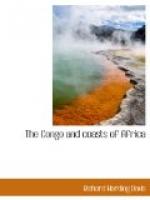In the “round up” of the logs the star performers were the three Kroo boys at the ship’s side. For days, in fascinated horror, the six passengers watched them, prayed for them, and made bets as to which would be the first to die. One understands that a Kroo boy is as much at home in the sea as on shore, but these boys were neither in the sea nor on shore. They were balancing themselves on blocks of slippery wood that weighed a ton, but which were hurled about by the great waves as though they were life-belts. All night the hammering of the logs made the ship echo like a monster drum, and all day without an instant’s pause each log reared and pitched, spun like a barrel, dived like a porpoise, or, broadside, battered itself against the iron plates. But, no matter what tricks it played, a Kroo boy rode it as easily as though it were a horse in a merry-go-round.
It was a wonderful exhibition. It furnished all the thrills that one gets when watching a cowboy on a bucking bronco, or a trained seal. Again and again a log, in wicked conspiracy with another log, would plan to entice a Kroo boy between them, and smash him. At the sight the passengers would shriek a warning, the boy would dive between the logs, and a mass of twelve hundred pounds of mahogany would crash against a mass weighing fifteen hundred with a report like colliding freight cars.
And then, as, breathless, we waited to see what once was a Kroo boy float to the surface, he would appear sputtering and grinning, and saying to us as clearly as a Kroo smile can say it: “He never touched me!”
[Illustration: A Log of Mahogany Jammed in the Anchor Chains.]
Two days after we had stored away the mahogany we anchored off Duala, the capital of the German Cameroons. Duala is built upon a high cliff, and from the water the white and yellow buildings with many pillars gave it the appearance of a city. Instead, it is a clean, pretty town. With the German habit of order, it has been laid out like barracks, but with many gardens, well-kept, shaded streets, and high, cool houses, scientifically planned to meet the necessities of the tropics. At Duala the white traders and officials were plump and cheerful looking, and in the air there was more of prosperity than fever. The black and white sentry boxes and the native soldiers practising the stork march of the Kaiser’s army were signs of a rigid military rule, but the signs of Germany’s efforts in trade were more conspicuous. Nowhere on the coast did we see as at Duala such gorgeous offices as those of the great trading house of Woermann, the hated rivals of “Sir Alfred,” such carved furniture, such shining brass railings, and nowhere else did we see plate-glass windows, in which, with unceasing wonder, the natives stared at reflections of their own persons. In the river there was a private dry dock of the Woermanns, and along the wharfs for acres was lumber for the Woermanns, boxes of trade goods, puncheons and casks for the Woermanns, private cooper shops and private machine shops and private banks for the Woermanns. The house flag of the Woermanns became as significant as that of a reigning sovereign. One felt inclined to salute it.




